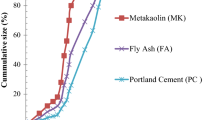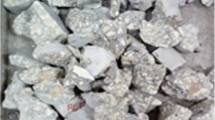Abstract
This paper presents an investigation of the use of recycled lightweight aggregate from waste autoclaved aerated concrete block to make lightweight pervious concrete (LWPC). The effects of fine sand (SA) and fly ash (FA) as additive materials on LWPC properties were also studied. The density, total void ratio, water permeability, compressive strength, splitting tensile strength, flexural strength, thermal conductivity, and surface abrasion of LWPC were tested. The results showed that all LWPCs had low density of 775–900 kg/m3 and low thermal conductivity coefficient of 0.15–0.27 W/m K. The use of SA and FA improved the compressive strength, splitting tensile strength, flexural strength, and abrasion resistance of LWPC, while the total void ratio and water permeability seemed to reduce. The low thermal conductivity and low density of LWPC with reasonable 28-day compressive strength of 1.9–4.1 MPa suggested that it is suitable for use as thermal insulating concrete.
Similar content being viewed by others
References
ACI Committee 213.: Guide for structural lightweight aggregate concrete (ACI 213R-03), American Concrete Institute, Detroit (2003)
Aguilar A.A., Diaz O.B., Garcia J.I.E.: Lightweight concretes of activated metakaolin-fly ash binders, with blast furnace slag aggregates. Constr. Build. Mater. 24, 1166–1175 (2010)
Sales A., de Souza F.R., dos Santos W.N., Zimer A.M., doCoutoRosa Almeida F.: Lightweight composites concrete product with water treatment sludge and sawdust: Thermal properties and potential application. Constr. Build. Mater. 24, 1069–1077 (2010)
Kralj D.: Experimental study of recycling lightweight concrete with aggregate containing expanded glass. Process Saf. Environ. Prot. 87, 267–273 (2009)
Fraj A.B., Kismi M., Mounanga P.: Valorization of coarse rigid polyurethane foam waste in lightweight aggregate concrete. Constr. Build. Mater. 24, 1069–1077 (2010)
Posi P., Teerachanwit C., Tanutong C., Limkamoltip S., Lertnimoolchai S., Sata V., Chindaprasirt P.: Lightweight geopolymer concrete containing aggregate from recycle lightweight block. Mater. Des. 52, 580–586 (2013)
Alexander Bogas J., de Brito J., Cabaco J.: Long-term behavior of concrete produced with recycled lightweight expanded clay aggregate concrete. Constr. Build. Mater. 65, 470–479 (2014)
ACI Committee 522.: Pervious Concrete (ACI 522R-10), American Concrete Institute, Detroit (2010)
Zaetang Y., Wongsa A., Sata V., Chindaprasirt P.: Use of lightweight aggregates in pervious concrete. Constr. Build. Mater. 48, 585–591 (2013)
Kathirvel P., Saraswathy V., Karthik S.P., Sekar A.S.S.: Strength and durability of quaternary cement concrete made with fly ash, rice husk ash and limestone powder. Arab. J. Sci. Eng. 38, 589–598 (2013)
Guneyisi E., Gesoglu M., Mermerdas K.: Improving strength, drying shrinkage, and pore structure of concrete using metakaolin. Mater. Struct. 41, 937–949 (2008)
Sata V., Tangpagasit J., Jaturapitukkul C., Chindaprasirt P.: Effect of W/B ratios on pozzolanic reaction of biomass ashes in Portland cement matrix. Cem. Concr. Compos. 34(1), 94–100 (2012)
TIS 1505: Autoclaved aerated lightweight concrete elements, Thailand Industrial Standard (1998)
Japanese Industrial Standard (JIS) R5201. Physical testing methods for cement (1997)
Hatanaka S., Mishima N., Nakagawa T., Morihana H., Chindaprasirt P.: Finishing methods and compressive strength-void ratio relationships of in-situ porous concrete pavement. Comput. Concr. 10(3), 231–240 (2012)
ASTM, C 1754: Standard test method for density and void content of hardened pervious concrete. Annual book of ASTM standards, American Society for Testing and Materials (2012)
ASTM, C 39/C 39M-01: Standard test method for compressive strength of cylindrical concrete specimens. Annual book of ASTM standards, American Society for Testing and Materials (2003)
ASTM, C 496-96: Standard test method for splitting tensile strength of cylindrical concrete specimens. Annual book of ASTM standards, American Society for Testing and Materials (2003)
ASTM, C 293-02: Standard test method for flexural strength of concrete (Using sample beam with center-point loading). Annual book of ASTM standards, American Society for Testing and Materials (2003)
ASTM, C 944: Standard test method for abrasion resistance of concrete or mortar surfaces by the rotating-cutter method. Annual book of ASTM standards, American Society for Testing and Materials (1999)
Uysal H., Demirboga R., Sahin R., Gul R.: The effect of different cement dosage, slumps, and pumice aggregate ratios on the thermal conductivity and density of concrete. Cem. Concr. Res. 34, 845–848 (2004)
Sengul O., Azizi S., Karaosmanoglu F., Tasdemir M.A.: Effect of expanded perlite on the mechanical properties and thermal conductivity of lightweight concrete. Energy Build. 43, 671–676 (2011)
Kim H.K., Jeon J.H., Lee H.K.: Workability, and mechanical, acoustic and thermal properties of lightweight aggregate concrete with a high volume of entrained air. Constr. Build. Mater. 29, 193–200 (2012)
Neithalath N., Sumanasooriya M.S., Deo O.: Characterizing pore volume, sizes, and connectivity in pervious concretes for permeability prediction. Mater. Character 61, 802–813 (2010)
Kevern J.T., Schaefer V.R., Wang K.: Portland cement pervious concrete: A field experience from Sioux City. Open Constr. Build. Technol. J. 2, 82–88 (2008)
Sata V., Wongsa A., Chindaprasirt P.: Properties of pervious geopolymer concrete using recycled aggregates. Constr. Build. Mater. 42, 33–39 (2013)
Unal O., Uygunoglu T., Yildiz A.: Investigation of properties of low-strength lightweight concrete for thermal insulation. Build. Environ. 42, 584–590 (2007)
Tanyildizi H., Coskun A., Somunkiran I.: An experimental investigation of bond and compressive strength of concrete with mineral admixtures at high temperatures. Arab. J. Sci. Eng. 33(2B), 443–449 (2008)
ACI Committee 318.: Building code requirements for structural concrete and commentary (ACI 318R-11). American Concrete Institute, Detroit (2011)
Crouch L.K., Pitt J., Hewitt R.: Aggregate effects on pervious portland cement concrete static modulus of elastic. J. Mater. Civ. Eng. 19(7), 561–568 (2007)
Topcu I.B., Uygunoglu T.: Properties of autoclaved lightweight aggregate concrete. Build. Environ. 42, 4108–4116 (2007)
Jerman M., Keppert M., Vyborny J., Cerny R.: Hygric, thermal and durability properties of autoclaved aerated concrete. Constr. Build. Mater. 41, 352–359 (2013)
Losiewicz M., Halsey D.P., Dews S.J., Olomaiye P., Harris F.C.: An investigation into the properties of micro-sphere insulating concrete. Constr. Build. Mater. 10(8), 583–588 (1996)
Saygili A., Baykal G.: A new method for improving the thermal insulation properties of fly ash. Energy Build. 43, 3236–3242 (2011)
Wongkeo W., Thongsanitgarn P., Pimraksa K., Chaipanich A.: Compressive strength, flexural strength and thermal conductivity of autoclave concrete block made using bottom ash as cement replacement materials. Mater. Des. 35, 434–439 (2012)
Demirboga R., Gul R.: The effects of expanded perlite aggregate, silica fume and fly ash on the thermal conductivity of lightweight concrete. Cem. Concr. Res. 33(5), 723–727 (2003)
Valore R.C.: Insulating concretes. ACI J. Proc. 53(11), 509–532 (1956)
Atis A.D.: High volume fly ash abrasion resistant concrete. J. Mater. Civ. Eng. 14(3), 274–277 (2002)
Yuksel I., Bilir T.: Usage of industrial by-products to produce plain concrete elements. Constr. Build. Mater. 21(3), 686–694 (2007)
Yuksel I., Bilir T., Ozkan O.: Durability of concrete incorporating non-ground blast furnace slag and bottom ash as fine aggregate. Build. Environ. 42(7), 2651–2659 (2007)
Author information
Authors and Affiliations
Corresponding author
Rights and permissions
About this article
Cite this article
Chindaprasirt, P., Nuaklong, P., Zaetang, Y. et al. Mechanical and Thermal Properties of Recycling Lightweight Pervious Concrete. Arab J Sci Eng 40, 443–450 (2015). https://doi.org/10.1007/s13369-014-1563-z
Received:
Accepted:
Published:
Issue Date:
DOI: https://doi.org/10.1007/s13369-014-1563-z




